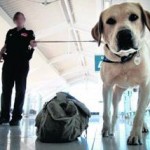 Most innovations we hear about these days involve some new technology, or some new application of an existing technology, but some of the most interesting and exciting innovations go in the opposite direction – seeing that something incredibly simple and low-tech is a better “how” to do something.
Most innovations we hear about these days involve some new technology, or some new application of an existing technology, but some of the most interesting and exciting innovations go in the opposite direction – seeing that something incredibly simple and low-tech is a better “how” to do something.
When it comes to testing and surveying for things, the use of animals is not new. Dolphins can be trained to look for mines, pigs are used to sniff out truffles, and we regularly see dogs at airports sniffing our luggage for drugs. I have been tempted to put some other smell on my luggage (like bacon) to get a reaction from the dog, but I don’t need that kind of attention, and then I am stuck with luggage that smells like bacon.
But a much more interesting king of testing has been devised. I read this article in the paper today about the use of bees at a German airport 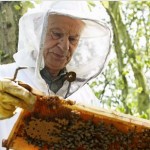 to test air quality levels. It’s really simple, they simply collect the honey from the bees and test it for toxins like certain hydrocarbons and heavy metals. As we read about bees disappearing from our farmlands, this seems like a creative way to re-introduce them into some areas and not only re-grow the bee population, but also learn a lot about air quality.
to test air quality levels. It’s really simple, they simply collect the honey from the bees and test it for toxins like certain hydrocarbons and heavy metals. As we read about bees disappearing from our farmlands, this seems like a creative way to re-introduce them into some areas and not only re-grow the bee population, but also learn a lot about air quality.
Not only is that really smart and easy and cheap, it makes me think that there have to be lots of other creatures that we can use to “listen” to water and air quality. It’s well known that some creatures are immune to various toxins, while others absorb them. The use of honey from bees is great because you don’t have to kill anything and it’s highly repeatable. My bet is that you could find several species of fish and birds that capture toxins and whether you collect feathers or droppings or whatever, I bet we could learn a lot more about the health and wellness of our environments, first as a snapshot, but then even more valuable would be the trend data so when you see a spike or just a shift, you know when it happened which makes diagnosing the cause a lot easier.
Great rethinking. And I love that it’s so low tech. I try to keep a repository of low tech examples of rethinking, and while I will add this to  the group, my favorite is still why Morton Salt uses their trademark phrase “when it rains it pours” – the answer is magnesium carbonate, but the more interesting part is what problem it solved. Any guesses?
the group, my favorite is still why Morton Salt uses their trademark phrase “when it rains it pours” – the answer is magnesium carbonate, but the more interesting part is what problem it solved. Any guesses?
-Ric
 Fashion, sports, science, politics, sports, business, arts, travel, the arts, etc, it’s all in there and extremely high quality reporting every day. Incredible photography as well. They made the shift to online as elegantly as any of the major paper publishers and I believe that they will survive the growing trend of people not reading newspapers any more as shorter digital content becomes more prevalent. Do I think my son will ever have a paper delivered to his house? No. And I think the expression “it was in the paper Wednesday” will fade because we don’t think of news as the daily chunk that a newspaper is, we get our information from many sources throughout the course of the day.
Fashion, sports, science, politics, sports, business, arts, travel, the arts, etc, it’s all in there and extremely high quality reporting every day. Incredible photography as well. They made the shift to online as elegantly as any of the major paper publishers and I believe that they will survive the growing trend of people not reading newspapers any more as shorter digital content becomes more prevalent. Do I think my son will ever have a paper delivered to his house? No. And I think the expression “it was in the paper Wednesday” will fade because we don’t think of news as the daily chunk that a newspaper is, we get our information from many sources throughout the course of the day. But they have figured out a way to hedge their bets with The New York Times Store. I have been aware of the store for a number of years (as far as I know it’s only an online store – I see the ads printed in the paper that is delivered to my house every day). I have seen countless ads for the store with the timeless image of Y.A. Tittle, helmet-less after a crushing loss as a New York (football) Giant. It sells for about $200 signed by Tittle. The tittle photo is one of many in a standard ad that has run for the store for years. That has always struck me as a simple but logical extension of the brand of the paper to sell copies of the photos it prints. Probably not a gigantic business, but worth the effort.
But they have figured out a way to hedge their bets with The New York Times Store. I have been aware of the store for a number of years (as far as I know it’s only an online store – I see the ads printed in the paper that is delivered to my house every day). I have seen countless ads for the store with the timeless image of Y.A. Tittle, helmet-less after a crushing loss as a New York (football) Giant. It sells for about $200 signed by Tittle. The tittle photo is one of many in a standard ad that has run for the store for years. That has always struck me as a simple but logical extension of the brand of the paper to sell copies of the photos it prints. Probably not a gigantic business, but worth the effort.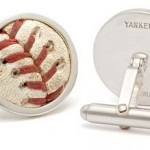 And to top it all off, they included off-the-charts great customer service which is consistent with how the customer service at the paper has performed.
And to top it all off, they included off-the-charts great customer service which is consistent with how the customer service at the paper has performed.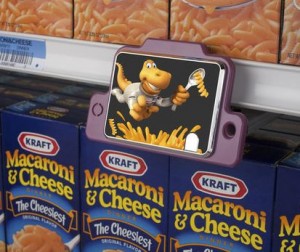 3GTV is the brainchild of Automated Media Services, and they are putting little screens in stores right next to products they promote and show commercials for those products. The notion of having what amounts to a tiny TV screen next to the Kraft Macaroni & Cheese would have sounded bizarre 20 years ago, not just because of cost, more because we didn’t think of TV screens being in very many places. Screens are everywhere today (mostly because of the low cost) and so we are less surprised to see them at restaurants and in elevators, etc.
3GTV is the brainchild of Automated Media Services, and they are putting little screens in stores right next to products they promote and show commercials for those products. The notion of having what amounts to a tiny TV screen next to the Kraft Macaroni & Cheese would have sounded bizarre 20 years ago, not just because of cost, more because we didn’t think of TV screens being in very many places. Screens are everywhere today (mostly because of the low cost) and so we are less surprised to see them at restaurants and in elevators, etc. Now things are really cooking with connecting marketers with consumers once we get this rolling. My guess is that Groupon, the ridiculously (their word, kind of) successful coupon company that just closed a $135 million round of financing will be in the mix. Add them to the list of “I wish I had thought of that!” Placebook and PointInside will also probably be in there.
Now things are really cooking with connecting marketers with consumers once we get this rolling. My guess is that Groupon, the ridiculously (their word, kind of) successful coupon company that just closed a $135 million round of financing will be in the mix. Add them to the list of “I wish I had thought of that!” Placebook and PointInside will also probably be in there.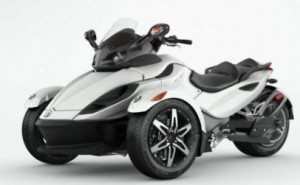 3) The Automotive Industry Is Getting Reinvented. Not tomorrow, but transportation is changing. The horrifying oil spill in the Gulf has renewed discussions of our need to get off of our dependence on oil, and while I think that’s both true and inevitable, I think the coming transformation is bigger than that. I have blogged in the past about how effectively Kodak successfully reinvented themselves by redefining the meaning of “The Kodak Moment”, Netflix has also successfully reinvented themselves in allowing people to stream movies directly instead of waiting for them in the mail (which is putting a lot of pressure on Comcast, by the way). In the case of both Kodak and Netflix, technology was what triggered the reinvention rethinking, and if they hadn’t reinvented themselves, I think both would have died or be near death soon. The reinvention that I think is coming is a more fundamental shift in the way we think about transportation. Already we are hearing about electric bikes and seeing things like the three-wheeled Can-Am (pictured at right) and I think those trends will only continue. The Zipcar is an idea that seemed a little kooky when it made its debut, but now it’s expected to go public it’s so popular. The trick for giants like G.M. is to understand what these trends mean to the market segments they target, and it might even mean targeting different markets.
3) The Automotive Industry Is Getting Reinvented. Not tomorrow, but transportation is changing. The horrifying oil spill in the Gulf has renewed discussions of our need to get off of our dependence on oil, and while I think that’s both true and inevitable, I think the coming transformation is bigger than that. I have blogged in the past about how effectively Kodak successfully reinvented themselves by redefining the meaning of “The Kodak Moment”, Netflix has also successfully reinvented themselves in allowing people to stream movies directly instead of waiting for them in the mail (which is putting a lot of pressure on Comcast, by the way). In the case of both Kodak and Netflix, technology was what triggered the reinvention rethinking, and if they hadn’t reinvented themselves, I think both would have died or be near death soon. The reinvention that I think is coming is a more fundamental shift in the way we think about transportation. Already we are hearing about electric bikes and seeing things like the three-wheeled Can-Am (pictured at right) and I think those trends will only continue. The Zipcar is an idea that seemed a little kooky when it made its debut, but now it’s expected to go public it’s so popular. The trick for giants like G.M. is to understand what these trends mean to the market segments they target, and it might even mean targeting different markets.